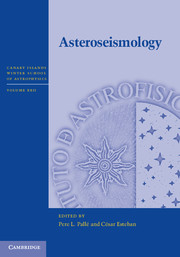Book contents
- Frontmatter
- Contents
- List of contributors
- List of participants
- Preface
- Acknowledgments
- Abbreviations
- 1 Sounding the solar cycle with helioseismology: Implications for asteroseismology
- 2 Learning physics from the stars: It's all in the coefficients
- 3 Solar-like oscillations: An observational perspective
- 4 Studying stars through frequency inversions
- 5 A crash course on data analysis in asteroseismology
- 6 An observer's views and tools
- 7 Asteroseismology of red giants
- References
1 - Sounding the solar cycle with helioseismology: Implications for asteroseismology
Published online by Cambridge University Press: 05 December 2013
- Frontmatter
- Contents
- List of contributors
- List of participants
- Preface
- Acknowledgments
- Abbreviations
- 1 Sounding the solar cycle with helioseismology: Implications for asteroseismology
- 2 Learning physics from the stars: It's all in the coefficients
- 3 Solar-like oscillations: An observational perspective
- 4 Studying stars through frequency inversions
- 5 A crash course on data analysis in asteroseismology
- 6 An observer's views and tools
- 7 Asteroseismology of red giants
- References
Summary
Introduction
My brief for the IAC Winter School was to cover observational results on helioseismology, flagging where possible implications of those results for the asteroseismic study of solar-type stars. My desire to make such links meant that I concentrated largely on results for low angular-degree (low-l) solar p modes, in particular results derived from “Sun-as-a-star” observations (which are, of course, most instructive for the transfer of experience from helioseismology to asteroseismology). The lectures covered many aspects of helioseismology – modern helioseismology is a diverse field. In these notes, rather than discuss each aspect to a moderate level of detail, I have instead made the decision to concentrate on one theme, that of “sounding” the solar activity cycle with helioseismology. I cover the topics from the lectures and I also include some new material, relating both to the lecture topics and to other aspects I did not have time to cover. Implications for asteroseismology are developed and discussed throughout.
The availability of long time series data on solar-type stars, courtesy of the NASA Kepler Mission (Chaplin et al., 2010; Gilliland et al., 2010) and the French-led CoRoT satellite (Appourchaux et al., 2008), is now making it possible to “sound” stellar cycles with asteroseismology. The prospects for such studies have been considered in some depth (Chaplin et al., 2007a, 2008a; Metcalfe et al., 2007; Karoff et al., 2009, e.g.), and in the last year the first convincing results on stellar-cycle variations of the p-mode frequencies of a solar-type star (the F-type star HD49933) were reported by García et al. (2010).
- Type
- Chapter
- Information
- Asteroseismology , pp. 1 - 31Publisher: Cambridge University PressPrint publication year: 2014



